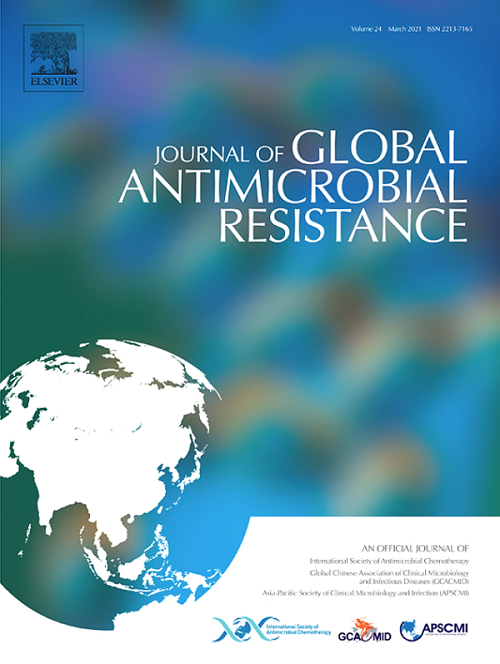奥马达环素对SENTRY抗菌监测项目中骨/关节感染细菌分离株和罕见病原体的体外活性研究(2015-2023)。
IF 3.2
3区 医学
Q2 INFECTIOUS DISEASES
引用次数: 0
摘要
目的:Omadacycline是美国食品和药物管理局(2018年)批准的一种氨基甲基环素(四环素类)抗菌药物,用于治疗由指指生物(口服和静脉制剂)引起的成人急性细菌性皮肤和皮肤结构感染(ABSSSI)和社区获得性细菌性肺炎(CABP)。奥马达环素对表达常见四环素耐药机制(核糖体保护蛋白和外排泵)的细菌分离物具有活性,这使得老一代四环素失去活性。作为SENTRY抗菌监测项目的一部分,研究人员对从美国和欧洲(2015-2023年)骨/关节感染患者中收集的919株细菌分离株和从美国(2015-2023年)患者(多个感染部位)收集的3945株罕见细菌病原体进行了奥马达环素体外活性评估。方法:肉汤微量稀释药敏试验遵循临床与实验室标准协会M07(2024)和M100(2024)指南。结果:奥马达环素对来自骨/关节感染患者的金黄色葡萄球菌(包括MRSA)、卢顿葡萄球菌、粪肠球菌(包括万古霉素耐药)和包括血管链球菌、肺炎链球菌和化脓性链球菌在内的链球菌的敏感性≥90.0% (FDA断点)。奥马达环素显示出对罕见革兰氏阳性病原体(多感染部位)的有效体外活性,对97.3%、91.3%和99.4%的罕见葡萄球菌、链球菌和肠球菌分离株的抑制作用达到或低于FDA批准的金黄色葡萄球菌、化脓性葡萄球菌和粪肠球菌的ABSSSI断点。结论:本研究中观察到的强有力的奥马达环素活性提示了治疗由各种葡萄球菌、链球菌和肠球菌引起的骨/关节感染和罕见的革兰氏阳性感染的潜在临床应用,并支持正在进行的针对这些疾病适应症的临床试验。本文章由计算机程序翻译,如有差异,请以英文原文为准。
In vitro activity of omadacycline against bacterial isolates from bone/joint infections and rare pathogens in the SENTRY antimicrobial surveillance program (2015–2023)
Objectives
Omadacycline is an aminomethylcycline (tetracycline class) antibacterial approved by the United States Food and Drug Administration (2018) for treatment of adults with acute bacterial skin and skin structure infection (ABSSSI) and community acquired bacterial pneumonia (CABP) caused by indicated organisms (oral and iv formulations). Omadacycline has activity against bacterial isolates expressing common tetracycline resistance mechanisms (ribosomal protection proteins and efflux pumps), which render older generation tetracyclines inactive. Omadacycline in vitro activity was assessed against 919 bacterial isolates collected from patients with bone/joint infections in the United States and Europe (2015–2023) and 3945 rarely encountered bacterial pathogens from patients (multiple infection sites) in the United States (2015–2023) as part of the SENTRY Antimicrobial Surveillance Program. program.
Methods
Broth microdilution susceptibility testing followed Clinical and Laboratory Standards Institute M07 (2024) and M100 (2024) guidelines.
Results
Omadacycline demonstrated susceptibilities of ≥90.0% (FDA breakpoints) against Staphylococcus aureus (including MRSA), Staphylococcus lugdunensis, Enterococcus faecalis (including vancomycin-resistant), and streptococci including Streptococcus anginosus, Streptococcus pneumoniae, and Streptococcus pyogenes from patient with bone/joint infections. Omadacycline demonstrated potent in vitro activity against rare Gram-positive pathogens (multiple infection sites), inhibiting 97.3%, 91.3%, and 99.4% of uncommon staphylococci, streptococci, and enterococci isolates at or below current FDA approved ABSSSI breakpoints for S. aureus, S. pyogenes, and E. faecalis.
Conclusions
The potent omadacycline activity observed in this study suggests potential clinical utility for treatment of bone/joint infections and rarely encountered Gram-positive infections caused by various staphylococci, streptococci, and enterococci isolates and supports ongoing clinical trials for these disease indications.
求助全文
通过发布文献求助,成功后即可免费获取论文全文。
去求助
来源期刊

Journal of global antimicrobial resistance
INFECTIOUS DISEASES-PHARMACOLOGY & PHARMACY
CiteScore
8.70
自引率
2.20%
发文量
285
审稿时长
34 weeks
期刊介绍:
The Journal of Global Antimicrobial Resistance (JGAR) is a quarterly online journal run by an international Editorial Board that focuses on the global spread of antibiotic-resistant microbes.
JGAR is a dedicated journal for all professionals working in research, health care, the environment and animal infection control, aiming to track the resistance threat worldwide and provides a single voice devoted to antimicrobial resistance (AMR).
Featuring peer-reviewed and up to date research articles, reviews, short notes and hot topics JGAR covers the key topics related to antibacterial, antiviral, antifungal and antiparasitic resistance.
 求助内容:
求助内容: 应助结果提醒方式:
应助结果提醒方式:


